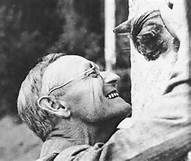Book Review: Siddhartha
In my freshman high school English class, we read a ton of classics: A Tale of Two Cities, Les Miserables (abridged), Hedda Gabler, and selections from The Odyssey. This was heavy-duty Literature (with a capital L), and you were supposed to comprehend the gravitas inherent in each.
But the three books I enjoyed the most were ones I’d never heard of before: Nectar in a Sieve (Kamala Markandaya), Growth of the Soil (Knut Hamsen), and Siddhartha. Both Nectarand Growth are stories of family struggles against the elements and society. Siddhartha is about a spiritual journey.
 I’ve read Siddhartha four times now. It’s my go-to book when I need to cleanse my palate. Plus, it’s short. After reading lengthy tomes (such as The Brothers Karamazov and A Game of Thrones), I need the freshness of brevity.
I’ve read Siddhartha four times now. It’s my go-to book when I need to cleanse my palate. Plus, it’s short. After reading lengthy tomes (such as The Brothers Karamazov and A Game of Thrones), I need the freshness of brevity.
The fact that I keep coming back to it, though, is not solely that it is a quick read. There is something decidedly peaceful about Siddhartha’s journey. A Brahmin’s son, he dispenses with the traditional education and elects to live an ascetic life. He encounters Gotama, the Buddha, and though he recognizes the teacher’s wisdom, Siddhartha is committed to following his own path. In other words, in order to learn, he must live.
Hesse’s novel follows Siddhartha through asceticism, capitalism, romance, and fatherhood. Each time he reaches the end of a path, he comprehends what he has learned. No lesson is pointless, and he is not ashamed of his time engaged with each occupation, but as he cycles through the phases of life, he reaches a point in which he craves something more.
“He felt he had thoroughly tasted and ejected a portion of sorrow, a portion of misery during those past times, that he had consumed them up to a point of despair and death. But all was well. He could have remained much longer with Kamaswami, made and squandered money, fed his body and neglected his soul; he could have dwelt for a long time yet in that soft, well-upholstered hell, if this had not happened, this moment of complete hopelessness and despair and the tense moment when he had bent over the flowing water, ready to commit suicide. This despair, this extreme nausea which he had experienced had not overpowered him. The bird, the clear spring and voice within him was still alive – that was why he rejoiced, that was why he laughed, that was why his face was radiant under his grey hair.” Who's my cutesy, little Nirvana?
Who's my cutesy, little Nirvana?
It’s deceptively simple language, rich with poetry and depth. The book reads almost as a parable, but Hesse never resorts to didactic purpose. Siddhartha’s journey may encounter recognizable milestones – love, career, family – but what pervades them all is the spiritual. Siddhartha remains focused on discovering the unity of life. Nirvana is not so much a goal but rather an awareness that it encompasses the whole of life: sin, desire, joy, laughter, love, despair.
About ten years ago I cleared off my over-stacked bookshelves and kept only those book that mean the most to me. The ones I will come back to again and again. Siddhartha is one of them.
But the three books I enjoyed the most were ones I’d never heard of before: Nectar in a Sieve (Kamala Markandaya), Growth of the Soil (Knut Hamsen), and Siddhartha. Both Nectarand Growth are stories of family struggles against the elements and society. Siddhartha is about a spiritual journey.
 I’ve read Siddhartha four times now. It’s my go-to book when I need to cleanse my palate. Plus, it’s short. After reading lengthy tomes (such as The Brothers Karamazov and A Game of Thrones), I need the freshness of brevity.
I’ve read Siddhartha four times now. It’s my go-to book when I need to cleanse my palate. Plus, it’s short. After reading lengthy tomes (such as The Brothers Karamazov and A Game of Thrones), I need the freshness of brevity.The fact that I keep coming back to it, though, is not solely that it is a quick read. There is something decidedly peaceful about Siddhartha’s journey. A Brahmin’s son, he dispenses with the traditional education and elects to live an ascetic life. He encounters Gotama, the Buddha, and though he recognizes the teacher’s wisdom, Siddhartha is committed to following his own path. In other words, in order to learn, he must live.
Hesse’s novel follows Siddhartha through asceticism, capitalism, romance, and fatherhood. Each time he reaches the end of a path, he comprehends what he has learned. No lesson is pointless, and he is not ashamed of his time engaged with each occupation, but as he cycles through the phases of life, he reaches a point in which he craves something more.
“He felt he had thoroughly tasted and ejected a portion of sorrow, a portion of misery during those past times, that he had consumed them up to a point of despair and death. But all was well. He could have remained much longer with Kamaswami, made and squandered money, fed his body and neglected his soul; he could have dwelt for a long time yet in that soft, well-upholstered hell, if this had not happened, this moment of complete hopelessness and despair and the tense moment when he had bent over the flowing water, ready to commit suicide. This despair, this extreme nausea which he had experienced had not overpowered him. The bird, the clear spring and voice within him was still alive – that was why he rejoiced, that was why he laughed, that was why his face was radiant under his grey hair.”
 Who's my cutesy, little Nirvana?
Who's my cutesy, little Nirvana?It’s deceptively simple language, rich with poetry and depth. The book reads almost as a parable, but Hesse never resorts to didactic purpose. Siddhartha’s journey may encounter recognizable milestones – love, career, family – but what pervades them all is the spiritual. Siddhartha remains focused on discovering the unity of life. Nirvana is not so much a goal but rather an awareness that it encompasses the whole of life: sin, desire, joy, laughter, love, despair.
About ten years ago I cleared off my over-stacked bookshelves and kept only those book that mean the most to me. The ones I will come back to again and again. Siddhartha is one of them.
Published on October 30, 2015 07:30
No comments have been added yet.



